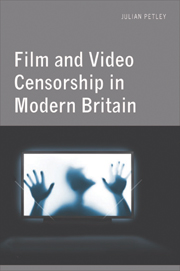Part I - Censorious Rigmarole and Legalistic Overkill
Published online by Cambridge University Press: 05 August 2013
Summary
Early in 1979 there are fewer than 100,000 VCRs in the UK, used mainly for time-shifting television programmes about once a month. Video rentals cost around £6.00 per night; EMI blank tapes retail at £7.00 for thirty minutes and £14.50 for 180 minutes. To buy a film on video costs from around £20 to £60. Unsurprisingly, the vast majority of films are watched on rented tapes. By the end of the year 250,000 VCRs are in use, 80 per cent of which are rented, but one in five Britons still doesn't know what video is. Because the major distributors are worried about both video piracy and denting their theatrical audiences (which in 1981 drop by 15 million on the previous year) they at first steer clear of the fledgling industry, which is thus dominated by a plethora of independents such as VCL, World of Video 2000, Intervision, Precision, Mountain VideoMedia, Hokushin and VIPCO. In 1979 UK video rights can be bought for as little as £1,000, and the video shelves are well stocked with cheap exploitation fare. The pornography industry is quick to spot the commercial potential of video, and in December 1979 the first Electric Blue cassette is launched, costing £31 on VHS or Beta and £38 on the short-lived V2000 Philips system. The first complaints about video advertising are made to the Advertising Standards Authority in 1981, and the first press stories about ‘video nasties’ appear in May 1982.
- Type
- Chapter
- Information
- Film and Video Censorship in Modern Britain , pp. 15 - 22Publisher: Edinburgh University PressPrint publication year: 2011



